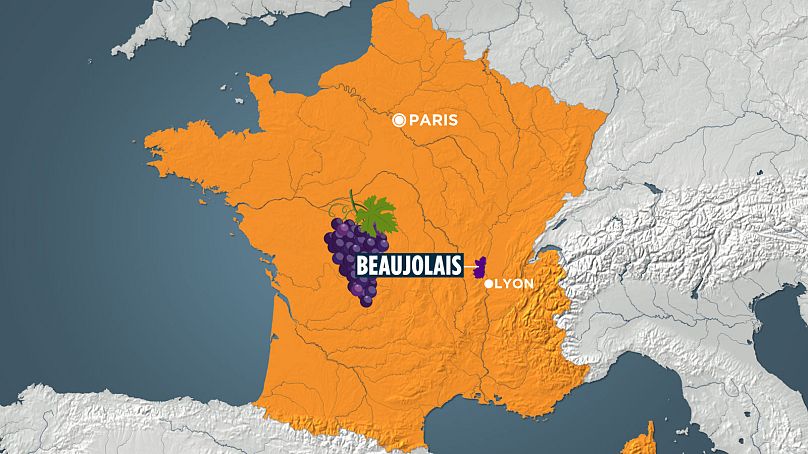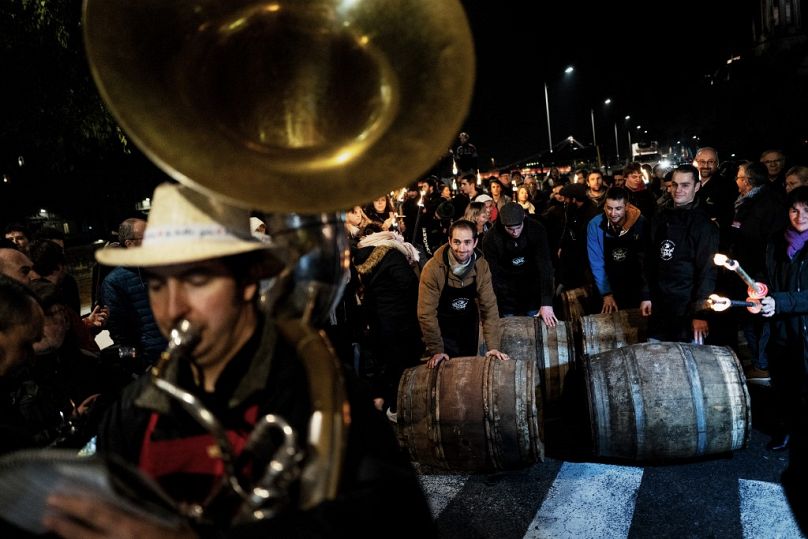The latest harvest’s first bottles of Beaujolais wine are sold from the third Thursday of November. The young and ‘new’ red wine had long suffered from a reputation of poor quality, but it has improved remarkably in recent years - without offsetting the festive side of the event.
Today marks the Beaujolais Nouveau, or ‘new Beaujolais’: The first opportunity you’ll get to taste this year’s vintage. The wine ages for less than three months in barrels, making it a very young wine.
Wine producers in Beaujolais, France are the only ones who can legally sell their wine this early following the harvest, which usually occurs in late August-early September.
About 25% of the grapes cultivated across the hilly eastern French region end up producing Beaujolais Nouveau.
Boosting the business
“It makes up between 15 and 20% of our annual revenues,” Beaujolais wine maker Gilles Gelin told Euronews Business. “It’s pretty significant. Beaujolais Nouveau creates occasions to party - and the party started over 70 years ago now.”
It was in 1951 that such wines were first put on the market with the official ‘Beaujolais Nouveau’ designation.
Restrictions during the Second World War meant that pretty much every bottle of wine in circulation had been drunk up during that period - pushing producers to offer young wines to thirsty French citizens as soon as production resumed.
When the government tried to regulate how early wine could be commercialised, pushing the date until after the Christmas holidays, Beaujolais wine makers got the green light to do so earlier.
Soon, many understood how beneficial it would be for business, and not just in France: Half of the Beaujolais produced every year is exported, the majority to Japan, the US and the UK.
“Its rise to fame can be attributed to the late Georges Duboeuf, who was a brilliant marketer and made celebrating Beaujolais Nouveau Day a holiday around the world,” wine expert Caroline Conner explained.
‘The answer to overpriced Burgundy’
“Beaujolais Nouveau was extremely popular from the late 70s through the early 90s,” Conner said.
However, its rather simple flavours failed to satisfy the taste buds of the 1990s public, who had got used to more sophisticated reds.
Food and wine critics were harsh, damaging the reputation of the young wine whose light and festive elements were not enough to keep it in the limelight.
The worst year for Beaujolais Nouveau producers was 2001: they’d brought out way too much wine, prompting its market value to plummet. The French government ordered one million cases of the new red wine’s vintage to be destroyed.
It was a wake-up call for the industry. The production has since decreased in quantity, but regained its quality.
“Everything bad we could hear about Beaujolais Nouveau is from two decades ago. To me, it’s in the past,” said Gilles Gelin. “It is a real wine, and it’s very complicated to make. It’s like rosé: everyone thinks it’s easy to make, but you have to be very precise in the making.”
Concentrating on smaller batches, the latest generation of winemakers has refined the quality of the Beaujolais Nouveau and helped restore its reputation.
“These are people who are under 40 and studied winemaking at university before travelling to other countries to learn abroad,” explained Caroline Conner. “They came home and have taken up the hard job of changing our minds about this unsung region. Beaujolais is the answer to overpriced Burgundy.”
A wine made to party
Beaujolais Nouveau’s rejuvenated reputation stands firm on remaining popular and festive, unlike many French grands vins.
The wine can only be commercialised from the third Thursday of November each year. Many take to wine shops, bars and restaurants to enjoy a glass of the latest vintage at lunchtime.
Some don’t wait that long and take part in the many festive events being held from midnight sharp on the night between Wednesday and Thursday, with glasses of Beaujolais Nouveau being served directly from the barrel.
More peculiar events are also held to celebrate the wine’s arrival, such as marathons or hikes in the Beaujolais region, where a glass of Nouveau awaits participants every few kilometres.
“Beaujolais Nouveau is a wine to share, to enjoy, to be together. It creates an occasion to party during a month that can be a bit sad,” Gelin told Euronews Business.













